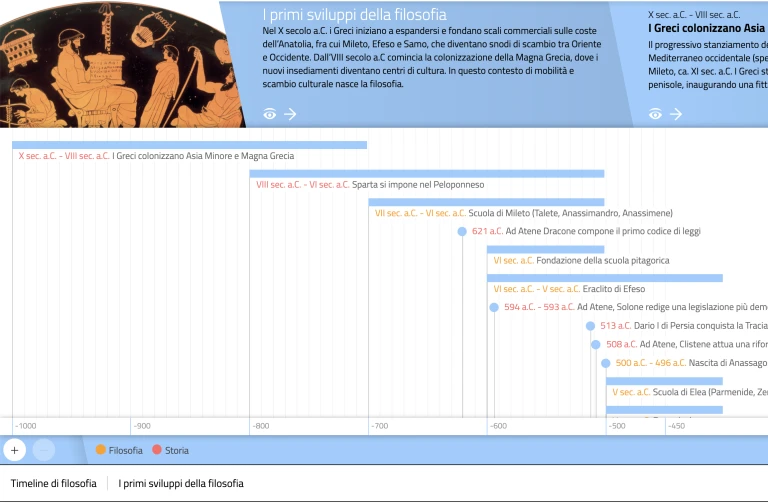Collezioni, Biblioteca, Museo, Storia
Solid data architecture and a component-based design to meet teaching needs quickly and efficiently.
For teachers, preparing a lesson means collecting and adapting different kinds of material from a range of sources, including texts, images, videos, animations, timelines, maps and exercises. For publishers, it means creating a platform where they can be grouped together, made accessible and published rapidly according to teachers’ study plans and didactic requirements. For students, it means enjoying a study environment that is simple, intuitive and shared with the class.




A science laboratory has different needs to a museum, a library requires a focus on texts, and an art gallery needs to organise everything around images.
To satisfy these requirements, we had to adopt design practices, methods and tools to guarantee and enhance the heterogeneity of materials, formats, contents and spheres of use.
So, the keys to this project were Agile, Components, UI and UX that were used by the whole team.
This is the recipe. Ingredients: texts, images, videos, timelines, maps and exercises. Method: abstract the formal qualities from the contents. Then, taking care of the semantic quality and design for (and of) the components, pour everything into a BEdita framework, and serve on made-to-measure platforms for students, teachers and editors.
This approach, shared with Zanichelli (project owner) and project stakeholders, and focused on contents like App&Ars literature editorial teams, allowed us to construct a work environment packed with interactions and exchanges thanks to Agile methodology.
This led to the creation, in this order, of Collezioni (Collections), Biblioteca (Library) and Museo di Itinerario nell’arte (The Journey into Art Museum). These three distinct environments have different contents and users, but they all share the same team, the same technologies and the same tools. They all allow users to group together, search for and organise multimedia material.
Collezioni, Biblioteca and Museo with their different functions and interfaces share the same database and the same approach to design and development.
Even if Collezioni, Biblioteca and Museo share the same functions and bases, they adapt rapidly to different contexts and offer users unique experiences.
For publishers this means being able to develop their editorial range rapidly and to guarantee and keep contents solid and usable over time, while also offering a personal and calibrated experience for different subjects, ages and types of teaching.
Collezioni puts the publishing house’s many multimedia contents at the disposal of teachers and students. It presents a wealth of digital textbook backup material in a user-friendly manner. Collezioni makes searching for, grouping and sharing this material for conducting lessons easy and intuitive.




Biblioteca is a platform dedicated to Italian literature. As with Collezioni, multimedia contents, like videos, documents and timelines can be searched for and collected and texts of Italian literature and interactive text analyses can also be used to create lessons.




Il Museo di Itinerario nell’arte, is an environment that originated in the Zanichelli arte History of Art Journey course. The environment reconstructs a museum in which high-definition works of art can be explored. There are also info sheets for artists and museums, a glossary, an anthology of sources and many other multimedia contents. Museo can be used to prepare lessons by collecting works, texts and multimedia elements.




Storia in digitale (History in digital) format accompanies the Zanichelli edition Noi di ieri, noi di domani. By accessing the portal, the user can explore a vast archive of historical documents, historiographic texts, images, videos, timelines, maps and ready-to-use theme trails. The sources can be collected in personalised formats, integrated with users’ own material and shared rapidly through recent online education platforms (Classi Virtuali Zanichelli, Google Classroom, Microsoft Teams).




Shared and semantic databases, the design and development of modular components, teamwork with a high degree of interaction and the integration of visual design and coding, software design and architecture, all allow existing products to be developed rapidly or created afresh to suit specific users with considerable savings in time and cost.
